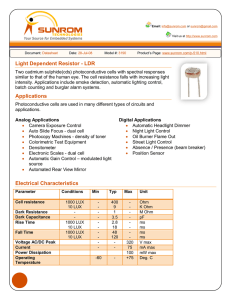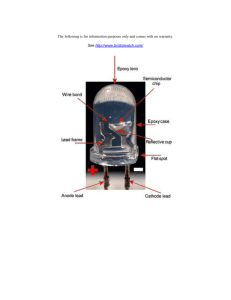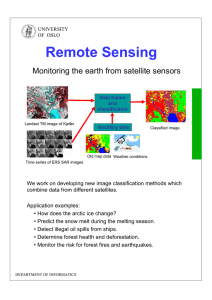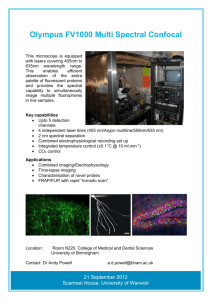Application Notes—Photoconductive Cells
advertisement
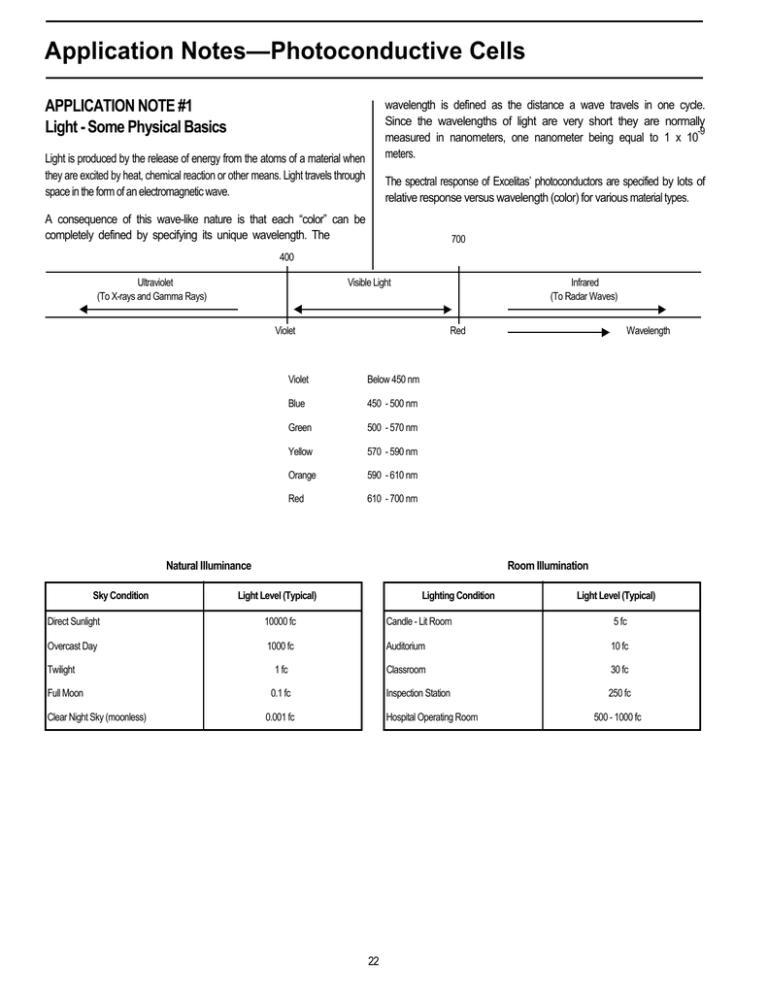
Application Notes—Photoconductive Cells APPLICATION NOTE #1 Light - Some Physical Basics wavelength is defined as the distance a wave travels in one cycle. Since the wavelengths of light are very short they are normally -9 measured in nanometers, one nanometer being equal to 1 x 10 meters. Light is produced by the release of energy from the atoms of a material when they are excited by heat, chemical reaction or other means. Light travels through space in the form of an electromagnetic wave. The spectral response of Excelitas’ photoconductors are specified by lots of relative response versus wavelength (color) for various material types. A consequence of this wave-like nature is that each “color” can be completely defined by specifying its unique wavelength. The 700 400 Ultraviolet (To X-rays and Gamma Rays) Visible Light Infrared (To Radar Waves) Violet Red Violet Below 450 nm Blue 450 - 500 nm Green 500 - 570 nm Yellow 570 - 590 nm Orange 590 - 610 nm Red 610 - 700 nm Natural Illuminance Sky Condition Wavelength Room Illumination Light Level (Typical) Lighting Condition Light Level (Typical) Direct Sunlight 10000 fc Candle - Lit Room 5 fc Overcast Day 1000 fc Auditorium 10 fc 1 fc Classroom 30 fc Inspection Station 250 fc Twilight Full Moon Clear Night Sky (moonless) 0.1 fc 0.001 fc Hospital Operating Room 22 500 - 1000 fc Application Notes—Photoconductive Cells APPLICATION NOTE #2 Light Resistance Measurement Techniques APPLICATION NOTE #3 Spectral Output of Common Light Sources The light resistance or “on” resistance (RON) of a photoconductor cell is defined as the resistance of the cell as measured at a special light level using a light source with a known output spectrum. Furthermore, the cell must be “light adapted” for a specific period of time at an established level of illumination in order to achieve repeatable results. Incandescent lamps can be considered as black body radiators whose spectral output is dependent on their color temperature. The sun has approximately the same spectral radiation distribution as that of a black body @ 5900 K. However, as viewed from the surface of the earth, the sun's spectrum contains H2O and CO2 absorption bands. The industry standard light source used for light resistance measurements is a tungsten filament lamp operating at a color temperature of 2850 K. Specifying the 2850 K color temperature for the light source fixes the spectral output (i.e. the tungsten filament light has fixed amounts of blue, green, red, and infrared light). For consistency and ease of comparing different cells, Excelitas lists light resistance values for its photocells at two standard light levels: 2 fc (footcandles) and at 10 lux. The footcandle is the old, historical unit for measuring light intensity and is defined as the illumination produced when the light from one standard candle falls normally on a surface at a distance of one foot. The lux (the metric unit of light measurement) is the illumination produced when the light from one candle falls normally on a surface of one meter. The conversion between footcandle and lux. is as follows: Black Body Sources Output vs. Wavelength Fluorescent lamps exhibit a broad band spectral output with narrow peaks in certain parts of the spectrum. Shown below is a plot of the light output of a typical daylight type fluorescent tube. 1.0 fc = 10.76 lux 1.0 lux = 0.093 fc As explained in the section on “Selecting a Photocell”, the “light history” effect necessitates the pre-conditioning of the cell before a light resistance measurement is made. Excelitas stores all cells at room temperature for 16 hours minimum at 30 - 50 fc (about 320 - 540 lux) prior to making the test measurement. Sometimes the design engineer or user does not have access to the precision measurement equipment necessary to determine the light levels or light intensities of the application. Should this prove to be a problem, calibrated photocell samples with individual data can be provided by Excelitas. Fluorescent Lamp Output vs. Wavelength Due to their long operating lifetimes, small size, low power consumption, and the fact they generate little heat, LEDs are the light sources of choice in many applications. When biased in the forward direction LEDs emit light that is very narrow in spectral bandwidth (light of one color). The “color” of the light emitted depends on which semiconductor material was used for the LED. 23 Application Notes—Photoconductive Cells LED Light Sources LED Type Color λP GaP GREEN 569 nm GaAsP/GaP YELLOW 585 nm GaAsP/GaP ORANGE 635 nm GaAsP/GaAs RED 655 nm AIGaAs RED 660 nm GaP/GaP RED 697 nm GaAIAs INFRARED 880 nm GaAs INFRARED 940 nm The LED/photocell matching factors listed are independent of power output from the LEDs. In order to get a real feel on how well any LED/ photocell pair couple together, the power output from the LED at a particular forward drive current must be considered. Normalized LED/Photocell Matching LED Type APPLICATION NOTE #4 Spectral Matching of LEDs and Photoconductive Types λP (nm) Type Ø Material Type 3 Material GaP 569 39% 40% GaAsP/GaP 58 60% 52% GaAsP/GaP 635 49% 38% GaAsP/GaAs 655 31% 27% AIGaAs 66 31% 27% GaP/GaP 697 47% 31% GaAIAs 880 — — GaAs 940 — — The intensity of the light being emitted by visible LEDs is often given in units of millicandela. Millicandela is photometric unit of measure which assumes the human eye as the detector. For most detectors other than the human eye the most convenient system for measurement is the radiometric system. Listed below is the typical light power output of some LEDs measured at two different forward drive currents. Note that LEDs of a given type can show a 5:1 manufacturing spread in power outputs. Since light sources and light detectors are almost always used together the designer must take into consideration the optical coupling of this system or the ability of the detector to “see” the light source. In order to have good optical coupling between the emitter and the conductor the spectral output of the light source must, to some degree, overlap the spectral response of the detector. If the design involves the use of a light source with a broad band spectral output the designer is assured that the photocell will have good response to the light. This may not be the case when an LED light source is employed. LEDs emit their light within a very narrow spectral band so that they are often considered to be emitting at only on (peak) wavelength. Power Output LED Type Spectral matching factors were calculated for a number of different LEDs and the photoconductor material types manufactured by Excelitas. Each matching factor was derived by multiplying the detector response curves by the LED spectral output curve and then measuring the resulting area. 24 Color λP (nm) If = 1 mA If = 10 mA 24.1 µW GaP GREEN 569 nm 1.2 µW GaAsP/GaP YELLOW 585 nm 0.3 µW 26.2 µW GaAsP/GaP ORANGE 635 nm 3.2 µW 101.9 µW GaAsP/GaAs RED 655 nm 6.2 µW 102.1 µW AIGaAs RED 660 nm 33.8 µW 445.1 µW GaP/GaP RED 697 nm 54.3 µW 296.2 µW GaAIAs INFRARED 880 nm 76.8 µW 1512.3 µW GaAs INFRARED 940 nm 35.5 µW 675.0 µW Application Notes—Photoconductive Cells APPLICATION NOTE #6 A Low Cost Light Source for Measuring Photocells Factoring in the power outputs of the LEDs, in this case at a forward drive current of 10 ma, coupling factors (matching factor multiplied by power output) for the various LED/material type combinations can be generated. Normalized LED/Photocell Coupling Factors @ 10 mA LED Type GaP λP (nm) 569 Type Ø Type 3 3% 3% GaAsP/GaP 58 5% 5% GaAsP/GaP 635 17% 13% GaAsP/GaAs 655 11% 9% AIGaAs 66 47% 35% GaP/GaP 697 47% 31% GaAIAs 880 — — GaAs 940 — — The Light Source used in the measurement of photocell resistance must be characterized for intensity and spectral composition. Excelitas uses a tungsten filament lamp having a spectral output approximating a black body @ 2850 K with a known candlepower output at a specified voltage and current. While calibrated lamps of this type are available from the National Institute of Standards and Technology (formerly NBS) and private testing labs, a low cost alternative is to use a 100 W, inside frosted, tungsten filament lamp available from any home or hardware store. Such a lamp operated at 120 VAC will produce approximately 90 candlepower (cp) of illumination and a color temperature of 2700 K to 2800 K. Once gain, this data is intended as a general guide. LED power outputs can vary 5:1 between manufacturer lots. The relationship between candlepower and footcandle is: APPLICATION NOTE #5 Assembly Precautions candle power footcandle = --------------------------------------(distance in feet)2 When soldering the cell leads take all measures possible to limit the amount of heating to the photocell. The maximum recommended Since this equation assumes a point source of light, the distance between lamp and detector should be at least five times the lamp diameter. soldering temperature is 250°C with a solder duration of 5 seconds. Heat sink the LEDs if possible. Keep soldering iron 1/16 inch (1.6 mm) minimum from base of package when soldering. There are some characteristics of incandescent lamps which should be noted: Avoid chemicals which can cause metal corrosion. Do not clean the plastic coated cells with organic solvents (ketone types). Check with factory for specific cleaning recommendations. Finally refrain from storing the cells under high temperature and/or humidity conditions. If cells are stored in the dark for any length of time please “light adept” before testing (see section on Light History Effect). Storage in the dark will change both the sensitivity and decay time of the cell. 25 1. Color temperature increases with increasing wattage. 2. When operated at a constant current, light output rises with time. 3. When operated at a constant voltage, light decreases with time, especially during the first few hours. Application Notes—Photoconductive Cells APPLICATION NOTE #7 How to Specify a Low Cost Photocell Sometimes the demands of the application such as power dissipation, “on” resistance, voltage, temperature coefficient, etc. limit the selection of the photocell to one particular device. However, more common is the case where any number of photocell types can be used, especially if minor changes are undertaken at an early enough point in the circuit design. In these cases, price is often the deciding factor. Many factors influence price. In order to give some guidance and weight to these factors the reader is referred to the following table which is meant to serve as a general guide. Lower Cost Factor Higher Cost Plastic Packaging Glass/Metal Broad Resistance Range Narrow Small Package Size Large Open Order with Scheduled Releases Scheduling Released Orders Standard Tests Testing Special Tests 26
